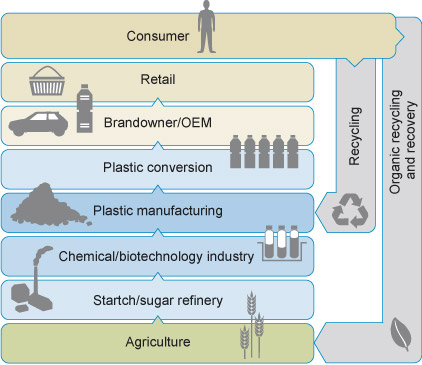2 The value of identifying value
In an important sense, an organisation is a machine for adding value. In its simplest form this means it takes an input at one value and, if successful, converts it to an output at a higher value.
The concept is seen most clearly in manufacturing, where raw materials are worked on to produce finished goods that customers value and are prepared to pay a premium for. Whilst the raw materials or components already had worth, the process of manufacturing added more value.
Figure 2 charts a chain within the production of bio-plastics, and shows different levels at which value is added. Read it from the bottom up, starting with the agricultural industry, which produces crops which are refined to obtain starch and sugars. Subsequent links in the chain convert these to plastics which are moulded to serve a vast array of consumer uses.
There are three further points about Figure 2 to note:
- In a chain like this there could be several different organisations collaborating – or one large organisation could own the different links in the chain – an arrangement known as ‘vertical integration’. Particular organisations may have a monopoly at certain levels, or there may be a range of organisations at the different levels competing for business.
- Between the levels of plastic conversion and retailer lies ‘Brand owner/OEM’. We will learn more about the value added at this stage in Activity 1. OEM stands for Original Equipment Manufacturer, and represents companies that make a component which is used in another company’s final output.
- Note the two recycling arrows to the right of Figure 2. These provide further routes through which value can be generated after the consumer has finished with the product. This is one example of cross-linkage within a value chain (or value network).
These points indicate ways in which the systems of production are far more complicated than the simple metaphor of a ‘chain’ suggests.
Value is added incrementally by various people, activities and procedures. Often their contribution is not easy to see as a simple sequence of events. Chains of value run through economies, industries and organisations from suppliers to customers, with numerous, often complicated, systems and processes. Many processes are not linear, nor are they straightforward to follow. There may be iterative or repeated procedures involved and cycles of feedback. The production process may require matrix teams (teams of people from diverse backgrounds) collaborating to produce or deliver something, making it difficult to see precisely how each individual involved contributes to the value that results.
In understanding value and the way it is created through organisations, it is vital to bear in mind that organisations (and to an even greater extent, wider industries and economies) are complex systems. They involve a number of interacting components which together display nonlinear behaviour. A change to one aspect of the system can have disproportionate, far- and wide-ranging impacts on many other components.
To put this in terms of your own work and commercial awareness: the value that you are able to add to a system of production or service delivery impacts on, and is impacted on by, the values added and costs incurred by others across the organisation. For this reason it is not just your specialist role, nor only your immediate neighbours in a value chain, that you need to be aware of. Commercial awareness requires a much more holistic approach to learning across and beyond the organisation. In the rest of this course we look in more depth at this organisational level.

